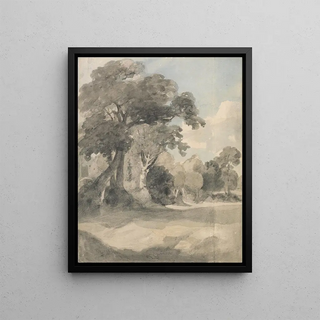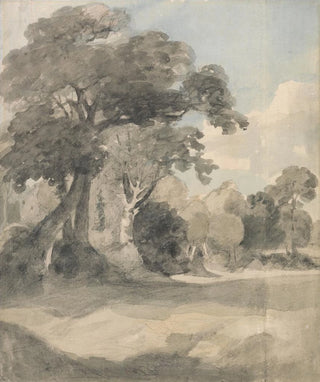Art print | Trees in a meadow - John Constable


View from behind

Frame (optional)
Reproduction of Trees in a Meadow - John Constable – Captivating Introduction
In the panorama of art history, certain works stand out for their ability to capture the very essence of nature. "Trees in a Meadow" by John Constable is a quintessential example. This painting, created in the early 19th century, evokes a bucolic vision of England, where the gaze is drawn to the majesty of the trees, symbols of life and longevity. The piece, both simple and complex, invites us to a deep contemplation, an immersion in a landscape that feels both familiar and timeless. Through this art print, we have the opportunity to rediscover the beauty of natural elements, while allowing ourselves to be carried by the emotion evoked by this peaceful scene.
Style and uniqueness of the work
John Constable's style is characterized by a realistic approach and meticulous attention to detail. In "Trees in a Meadow," light plays a crucial role, illuminating the foliage and creating delicate shadows on the ground. The colors, rich and vibrant, evoke a palette inspired by nature itself, ranging from deep greens to warm browns. This art print stands out for its serene atmosphere, where each tree seems to tell a story, each blade of grass fits into perfect harmony. Constable does not merely reproduce reality; he elevates it, offering the viewer a visual experience that transcends mere observation. The composition, balanced and fluid, guides us through the landscape, encouraging us to explore every corner, every nuance, as if we ourselves were immersed in this lush meadow.
The artist and his influence
John Constable, a major figure of English Romanticism, managed to leave his mark on his era with his unique vision of nature. Born in 1776, he dedicated his life to painting landscapes, seeking to capture the beauty of rural scenes from his homeland. His influence is undeniable, inspiring many artists, both contemporaries and successors. Constable introduced a new way of perceiving the landscape, transforming it into a subject of emotion and reflection. His approach, which combines meticulous observation and personal expression, paved the way for subsequent artistic movements.

Matte finish

View from behind

Frame (optional)
Reproduction of Trees in a Meadow - John Constable – Captivating Introduction
In the panorama of art history, certain works stand out for their ability to capture the very essence of nature. "Trees in a Meadow" by John Constable is a quintessential example. This painting, created in the early 19th century, evokes a bucolic vision of England, where the gaze is drawn to the majesty of the trees, symbols of life and longevity. The piece, both simple and complex, invites us to a deep contemplation, an immersion in a landscape that feels both familiar and timeless. Through this art print, we have the opportunity to rediscover the beauty of natural elements, while allowing ourselves to be carried by the emotion evoked by this peaceful scene.
Style and uniqueness of the work
John Constable's style is characterized by a realistic approach and meticulous attention to detail. In "Trees in a Meadow," light plays a crucial role, illuminating the foliage and creating delicate shadows on the ground. The colors, rich and vibrant, evoke a palette inspired by nature itself, ranging from deep greens to warm browns. This art print stands out for its serene atmosphere, where each tree seems to tell a story, each blade of grass fits into perfect harmony. Constable does not merely reproduce reality; he elevates it, offering the viewer a visual experience that transcends mere observation. The composition, balanced and fluid, guides us through the landscape, encouraging us to explore every corner, every nuance, as if we ourselves were immersed in this lush meadow.
The artist and his influence
John Constable, a major figure of English Romanticism, managed to leave his mark on his era with his unique vision of nature. Born in 1776, he dedicated his life to painting landscapes, seeking to capture the beauty of rural scenes from his homeland. His influence is undeniable, inspiring many artists, both contemporaries and successors. Constable introduced a new way of perceiving the landscape, transforming it into a subject of emotion and reflection. His approach, which combines meticulous observation and personal expression, paved the way for subsequent artistic movements.






